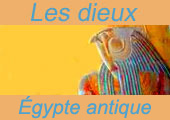- Ashtart
-
Astarté

Cet article fait partie de la série
Dieux égyptiensPrésentation Par ordre alphabétique Par relation Par ville Par symbole Par animal Par écriture hiéroglyphique Astarté est une déesse d'origine phénicienne présentant un caractère belliqueux, implantée dans la mythologie égyptienne sous les Ramessides. À califourchon sur son cheval, elle accompagne et protège le souverain. Elle devient la fille de Rê ou de Ptah, et est une des compagnes de Seth.
Athtart à Ougarit, Shaushka ou Shaushga chez les Hourrites, Ashtart en langue punico-phénicienne, elle est l'équivalent de la déesse mésopotamienne Ishtar (pour les babyloniens) ou Inanna (pour les sumériens).
Elle semble avoir comme descendance Aphrodite en Grèce, Turan en Étrurie et Vénus à Rome sous le nom officiel de Venere Ericina.
Elle est Tanit, chez les Carthaginois.
Tanit est une déesse d'origine phénicienne de la fertilité, présidant aux naissances et à la croissance. Elle était la déesse tutélaire de la ville de Sarepta et son culte prit de l'ampleur à Carthage où elle était nommée Oum.
Élément féminin du couple suprême qu'elle forme avec Baal, celle-ci assume des fonctions variées : protectrice du souverain et de sa dynastie, elle protège également les marins, mais son culte est, comme pour la plupart des divinités féminines primordiales de l'antiquité (et de la proto-histoire), lié à la fertilité et à la fécondité.
Le papyrus d'Astarté (papyrus fragmentaire) semble laisser entendre qu'Astarté est celle qui contrecarre les demandes exorbitantes de tribut que Yam (roi des dieux) demande aux autres dieux.
Bibliographie
- Gerd Scherm, Brigitte Tast, Astarte und Venus. Eine foto-lyrische Annäherung, 1996 (ISBN 3-88842-603-0)

Histoire • Géographie • Mythologie • Dieux • Art / Pyramides • Sciences • Vie quotidienne / Organisation politique / Pharaons Égyptologie • Bibliographie • Lexique • Index Egyptopedia Un article égyptologique au hasard : Modifications du jour - Portail de l’Égypte antique
- Portail de la Rome antique
- Portail du Proche-Orient ancien
- Portail des Phéniciens et du monde punique
Catégories : Mythologie phénicienne | Divinité romaine d'origine orientale | Divinité égyptienne
Wikimedia Foundation. 2010.
